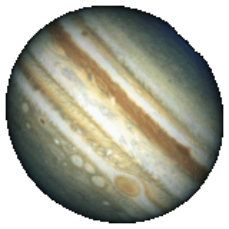Jupiter has dozens of moons orbiting it, as well as a dusty ring. The four biggest moons were first seen by Galileo over
four hundred years ago. Each of these four has some unique characteristic about it. Each has a distinctly different interior.
•
Io the innermost of the group,has a dozen or so volcanoes erupting at any given time. It’s hard to find craters on the
surface of Io since the surface is constantly being buried by those eruptions.
•
Europa has perhaps the smoothest surface of any object in the solar system. It is also the closest thing to a perfect sphere.
Beneath its icy surface we suspect an ocean of liquid water. Who knows what might live in that ocean?
•
Ganymede is the largest moon in the entire solar system. It appears as if Ganymede has an interior active enought to sustain plate tectonics on
the surface of this moon.
•
Callisto, is the outermost of the four. It is heavily battered with craters and apparently dead to the core.
There are also many more small moons that orbit the giant planet. Here is a table of their physical characteristics and their orbits.
Jupiter was highlighted in the sequel to 2001, “2010 The Year We Make Contact.
Let’s rejoin the fictional astronauts of the ‘Voyage to the Planets’ video as they explore Jupiter.











































